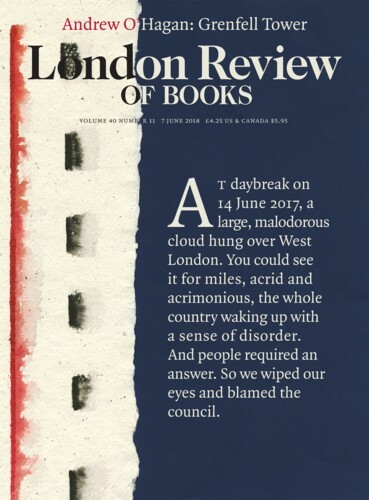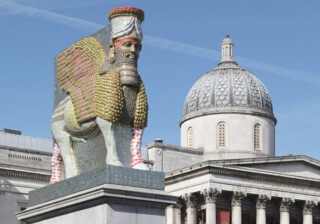Over the last twenty years the fourth plinth in Trafalgar Square has played host to 12 commissions, each a reminder that there’s no easy path to relevance, let alone aesthetic success. More than one work has breached the fine line separating populist eloquence from authorial laziness. In Antony Gormley’s One & Other (2009), 2400 volunteers (one an hour) took turns standing in for that upright figure that now signifies ‘Gormley’. With the plinth as a stage and the square their theatre, the artist’s surrogates danced, sang and otherwise confessed themselves, day in and day out. Cameras rolled, a safety net discouraged jumpers, while six stewards stood on permanent guard in case the ‘public’ decided to act up. In comparison, Katharina Fritsch’s cartoony blue Hahn/Cock (2013-15), came across as perfectly judged in relation to Nelson and his lions. At almost 16 feet high, the giant fibreglass rooster was lord of all he surveyed.
The plinth’s latest occupant, The Invisible Enemy Should Not Exist (until March 2020), is the work of the Chicago-based sculptor Michael Rakowitz. He has resurrected one of the world’s most impressive sculptural creations, the massive and marvellous chimera its Assyrian inventors termed the ‘lamassu’. I do mean marvellous. These are creatures that boast an eagle’s wide wings, a bull or lion’s tautly muscled body, and the benignly smiling head of a thick-bearded man. In the opinion of Henry Layard, the excavator of Nineveh, the beauty of the palace carvings showed a ‘spirit and truthfulness worthy of a Greek artist’. In 1853 there was no higher praise.
Layard quickly launched the laborious process of dispatching at least some of these huge carvings to the West. The rest were reburied on site, in the hope of keeping them safe. Those that travelled – there are examples in Baghdad, Paris, New York, Chicago and London – were carved to adorn, and perhaps protect, the gates and passages linking Nineveh to the outside world. The lamassu that Rakowitz took as his model went no farther than the Mosul Museum, just across the Tigris from the vast palace it was created for. There, in February 2015, along with other Assyrian artefacts accessioned for safekeeping, the Mosul lamassu fell victim to an Isis jackhammer; a video camera recorded the irreparably shattered fragments as they fell.
Rather like the lamassu that inspired him, Rakowitz is something of a hybrid. Born in New York in 1973, he remains strongly linked to the traditions of his family, Iraqi Jews whose reigning patriarch, Nissim Isaac Daoud bin Aziz, emigrated from Baghdad to Long Island in 1946. With Daoud came Davisons & Co, his import/export business, which Rakowitz resurrected in 2004, early in the Iraq War. The idea was to resume commerce, whatever its reach and scale. In the end, precious little changed hands. The dates the firm had hoped to import had become woefully scarce, a casualty of failed crops and faltering policies. As for other local products available for export, there were none. In the meantime, Rakowitz used the business to offer free shipment to Iraqis wishing to send home packages, or to anyone who had something to send to an Iraqi or an American fighting Saddam Hussein.
As the business of Davisons demonstrated, ‘import’ and ‘export’ mirror the formal ‘commerce’ of art. The push/pull interchange can sometimes harness the energy that sparks from combinatory, that is, hybridised, types. This seems to have happened as Layard looked at the chimerical lumasi and recognised their ‘spirit and truthfulness’. But then he changed his mind. By 1854, when plaster casts of his Nineveh finds were displayed at the rebuilt Crystal Palace, he had begun to call the carvings ‘monsters’, as if to deny the strange beauty he had initially perceived.
For Rakowitz there is no such simple choice. His lamassu is both marvel and monster. Made of brightly painted metal in lieu of limestone, its riveted skin has been pieced together from precisely cut and crimped steel. Rakowitz calls this covering ‘armour’, which makes a certain sense. Yet if it is armour, it’s cut, not forged: the pieces are taken from thousands of recycled cans. Each one held date syrup, another Iraqi export brought to a halt by war. Each was tailored to take its place in a shaped surface able to answer not only to the spread of the lamassu’s wings, in acid green and pink, but also to the massed fullness of his black beard. The gold background from which he emerges has a lemony hue. What a presence! In the May sun, the lamassu seems gentle, his smile benign as he looks to the south. Yet I sense that for Rakowitz this gentleness has been hard won. As he conducted it, the family import/export business was a way of making peace, of keeping lines of communication open. The work’s title comes to mind: invisible enemies should not exist. Would we be right to conclude that visibility is an essential condition of peace? Perhaps this is what, from its plinth, the lamassu envisions.
Send Letters To:
The Editor
London Review of Books,
28 Little Russell Street
London, WC1A 2HN
letters@lrb.co.uk
Please include name, address, and a telephone number.


